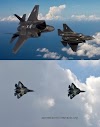Japan is taking bold steps toward reinventing aerial warfare, turning heads with its revived interest in the legendary Northrop YF‑23 “Black Widow II.” In a strategic pivot, the Air Self-Defense Force (ASDF) is reportedly exploring whether the iconic stealth prototype could underpin its next-generation F‑X (F‑3) fighter. Could a plane nearly mothballed since the early 1990s help Tokyo leapfrog into a sixth-generation future? With stealth, super-cruise capability and cutting-edge Japanese systems in play, this revival—inspired by footage from Inventor Eye—could reshape regional defense dynamics and reignite the YF‑23’s storied legacy.
A Forgotten Prototype with New Purpose
The Northrop YF‑23 first appeared in 1990 as one of two prototype competitors aiming for the U.S. Advanced Tactical Fighter program. Designed for stealth and speed, the “Black Widow II” offered diamond-shaped wings, V-shaped tail fins and an ultra-low radar cross-section—blending the agility of a fighter with the signature-staying power of a spy plane. Two prototypes (“Spider” and “Gray Ghost”) flew test missions totaling nearly 65 hours. Though it surpassed its rival in stealth and range, the Raptor won the contract, thanks to its exceptional thrust-vectoring agility.
Why Japan Is Revisiting the YF‑23
Fast forward to today. Tokyo has launched the Mitsubishi-led F‑X project—part of the collaborative Global Combat Air Programme with the UK and Italy—to field a cutting-edge sixth-generation fighter by the mid-2030s. In 2018, Northrop Grumman responded to Japanese outreach with its modernized YF‑23 concept, offering its stealth-optimized airframe, advanced engines, and hybrid design heritage. Japan's interest isn’t superficial—it is reportedly examining whether blending the YF-23’s proven low observability and super-cruise foundations with Japanese avionics, engines, and modular radar-absorbing materials could speed up development and reduce risk.
Context and Inverted Pyramid
Who & What:
Japan’s defense agency and Mitsubishi Heavy Industries are considering adding Northrop’s modernized YF‑23 to the mix for the F‑X fighter initiative.
When:
Following outreach to defense contractors in 2018; recent coverage reignited interest amid F‑X’s ongoing R&D phase.
Where:
Japan Air Self‑Defense Force development centers and Mitsubishi’s facilities in Japan.
Why:
The YF‑23’s stealth, range, and proven airframe could complement Japan’s need for advanced fifth/sixth-gen capabilities in a contested Indo-Pacific environment.
How:
By combining Northrop’s design with Japanese manufacturing, engines (by IHI), avionics and modular stealth tech.
Supporting Details & Expert Insight
The YF‑23’s diamond wing and V-tail design, highly refined for low radar signature, propelled it past the competition in stealth and super-cruise tests—capabilities still hard to mask today. . Japan’s interest is strategic: by leveraging a heritage airframe, it may shortcut typical early-phase delays. Experts note, however, that Malaysia redesigns—like sensor suites and radar absorbent materials—will be critical. Plus, even Northrop acknowledges upgrades would be essential before production. . Meanwhile, Japan also remains active in the Global Combat Air Programme—which melds elements of Tempest (UK) and its F‑X to push the envelope further.
In conclusion, reviving the YF‑23 could mark a transformative leap for Japan’s air-defense ambitions. By fusing a stealth-tested airframe with Japanese innovation, Tokyo may fast-track its F‑X fighter into service without starting from scratch. Still, integrating advanced sensors, engines, and stealth coatings remains a high-stakes challenge. Whether the “Black Widow II” returns to the skies or simply inspires a hybrid design, its comeback reflects a strategic shift: preferring stealth and reach over close-range dogfight agility. In an era defined by long-range threats and geopolitical tension, Japan may have found its co-pilot for a new age of aerial dominance.
Frequently Asked Questions:
Q: What is the YF‑23?
A: The Northrop YF‑23 was a stealth fighter prototype built in the 1990s for the USAF’s Advanced Tactical Fighter competition. It featured diamond wings, V-shaped tail fins, super‑cruise, and outstanding stealth—but lost to the Lockheed YF‑22 (F‑22 Raptor). Only two flew.
Q2: Why is Japan interested now?
A: Japan’s F‑X project—also called the F‑3—and the Global Combat Air Programme aim to field a domestic sixth‑generation fighter by the 2030s. The YF‑23 provides a proven low‑observable airframe and performance baseline that could accelerate development and reduce technical risk.
Q3: What upgrades are needed?
A: Major. Japan would need to retrofit modern engines (likely from IHI), advanced sensor suites, contemporary radar‑absorbent coatings, and digital avionics to meet current stealth and combat standards.
Q4: How does it compare to Japan’s F‑2 and Global Combat Air fighters?
A: The new F‑X/F‑3, potentially YF‑23-based, aims to replace the aging Mitsubishi F‑2. The Global Combat Air Programme (UK/Italy/Japan) seeks to combine Tempest and F‑X elements for enhanced interoperability and cutting‑edge capabilities.
Q5: When could a YF‑23-inspired fighter enter service?
A: If Japan smoothly integrates the design, production could begin in the early 2030s. Full deployment may occur by the mid‑2030s—timed with the broader GCAP schedule.






0 Comments